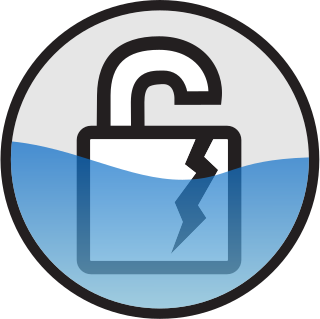Related Research Articles

Kerberos is a computer-network authentication protocol that works on the basis of tickets to allow nodes communicating over a non-secure network to prove their identity to one another in a secure manner. Its designers aimed it primarily at a client–server model, and it provides mutual authentication—both the user and the server verify each other's identity. Kerberos protocol messages are protected against eavesdropping and replay attacks.
The Secure Shell (SSH) Protocol is a cryptographic network protocol for operating network services securely over an unsecured network. Its most notable applications are remote login and command-line execution.
Telnet is a client/server application protocol that provides access to virtual terminals of remote systems on local area networks or the Internet. It is a protocol for bidirectional 8-bit communications. Its main goal was to connect terminal devices and terminal-oriented processes.
Simple Network Management Protocol (SNMP) is an Internet Standard protocol for collecting and organizing information about managed devices on IP networks and for modifying that information to change device behavior. Devices that typically support SNMP include cable modems, routers, network switches, servers, workstations, printers, and more.

An email client, email reader or, more formally, message user agent (MUA) or mail user agent is a computer program used to access and manage a user's email.
Password Authentication Protocol (PAP) is a password-based authentication protocol used by Point-to-Point Protocol (PPP) to validate users. PAP is specified in RFC 1334.
Transport Layer Security (TLS) is a cryptographic protocol designed to provide communications security over a computer network, such as the Internet. The protocol is widely used in applications such as email, instant messaging, and voice over IP, but its use in securing HTTPS remains the most publicly visible.
In computer security, challenge-response authentication is a family of protocols in which one party presents a question ("challenge") and another party must provide a valid answer ("response") to be authenticated.
Wi-Fi Protected Access (WPA), Wi-Fi Protected Access 2 (WPA2), and Wi-Fi Protected Access 3 (WPA3) are the three security certification programs developed after 2000 by the Wi-Fi Alliance to secure wireless computer networks. The Alliance defined these in response to serious weaknesses researchers had found in the previous system, Wired Equivalent Privacy (WEP).
Key management refers to management of cryptographic keys in a cryptosystem. This includes dealing with the generation, exchange, storage, use, crypto-shredding (destruction) and replacement of keys. It includes cryptographic protocol design, key servers, user procedures, and other relevant protocols.

Digest access authentication is one of the agreed-upon methods a web server can use to negotiate credentials, such as username or password, with a user's web browser. This can be used to confirm the identity of a user before sending sensitive information, such as online banking transaction history. It applies a hash function to the username and password before sending them over the network. In contrast, basic access authentication uses the easily reversible Base64 encoding instead of hashing, making it non-secure unless used in conjunction with TLS.
Extensible Authentication Protocol (EAP) is an authentication framework frequently used in network and internet connections. It is defined in RFC 3748, which made RFC 2284 obsolete, and is updated by RFC 5247. EAP is an authentication framework for providing the transport and usage of material and parameters generated by EAP methods. There are many methods defined by RFCs, and a number of vendor-specific methods and new proposals exist. EAP is not a wire protocol; instead it only defines the information from the interface and the formats. Each protocol that uses EAP defines a way to encapsulate by the user EAP messages within that protocol's messages.
A Systems Applications Products audit is an audit of a computer system from SAP to check its security and data integrity. SAP is the acronym for Systems Applications Products. It is a system that provides users with a soft real-time business application. It contains a user interface and is considered very flexible. In an SAP audit, the two main areas of concern are security and data integrity.
An information security audit is an audit of the level of information security in an organization. It is an independent review and examination of system records, activities, and related documents. These audits are intended to improve the level of information security, avoid improper information security designs, and optimize the efficiency of the security safeguards and security processes.
Separation of duties (SoD), also known as segregation of duties, is the concept of having more than one person required to complete a task. It is an administrative control used by organisations to prevent fraud, sabotage, theft, misuse of information, and other security compromises. In the political realm, it is known as the separation of powers, as can be seen in democracies where the government is separated into three independent branches: a legislature, an executive, and a judiciary.
In a Windows network, NT LAN Manager (NTLM) is a suite of Microsoft security protocols intended to provide authentication, integrity, and confidentiality to users. NTLM is the successor to the authentication protocol in Microsoft LAN Manager (LANMAN), an older Microsoft product. The NTLM protocol suite is implemented in a Security Support Provider, which combines the LAN Manager authentication protocol, NTLMv1, NTLMv2 and NTLM2 Session protocols in a single package. Whether these protocols are used or can be used on a system, which is governed by Group Policy settings, for which different versions of Windows have different default settings.
Database security concerns the use of a broad range of information security controls to protect databases against compromises of their confidentiality, integrity and availability. It involves various types or categories of controls, such as technical, procedural or administrative, and physical.
IEC 62351 is a standard developed by WG15 of IEC TC57. This is developed for handling the security of TC 57 series of protocols including IEC 60870-5 series, IEC 60870-6 series, IEC 61850 series, IEC 61970 series & IEC 61968 series. The different security objectives include authentication of data transfer through digital signatures, ensuring only authenticated access, prevention of eavesdropping, prevention of playback and spoofing, and intrusion detection.

The DROWN attack is a cross-protocol security bug that attacks servers supporting modern SSLv3/TLS protocol suites by using their support for the obsolete, insecure, SSL v2 protocol to leverage an attack on connections using up-to-date protocols that would otherwise be secure. DROWN can affect all types of servers that offer services encrypted with SSLv3/TLS yet still support SSLv2, provided they share the same public key credentials between the two protocols. Additionally, if the same public key certificate is used on a different server that supports SSLv2, the TLS server is also vulnerable due to the SSLv2 server leaking key information that can be used against the TLS server.
This is a list of cybersecurity information technology. Cybersecurity is security as it is applied to information technology. This includes all technology that stores, manipulates, or moves data, such as computers, data networks, and all devices connected to or included in networks, such as routers and switches. All information technology devices and facilities need to be secured against intrusion, unauthorized use, and vandalism. Additionally, the users of information technology should be protected from theft of assets, extortion, identity theft, loss of privacy and confidentiality of personal information, malicious mischief, damage to equipment, business process compromise, and the general activity of cybercriminals. The public should be protected against acts of cyberterrorism, such as the compromise or loss of the electric power grid.
References
- ↑ "What Is ERP?" . Retrieved 6 April 2018.
- 1 2 3 Security issues in ERP http://www.isaca.org/Knowledge-Center/Research/ResearchDeliverables/Pages/sap-erp.aspx Archived 2015-11-09 at the Wayback Machine
- ↑ "Why security should be a priority for an ERP ecosystem". Information Age. 31 August 2017. Retrieved 6 April 2018.
- 1 2 ERP Security and Segregation of Duties Audit: A Framework for Building an Automated Solution https://csbweb01.uncw.edu/people/ivancevichd/classes/MSA%20516/Extra%20Readings%20on%20Topics/Database/ERP%20Security.pdf
- 1 2 "ERP Security Deserves Our Attention Now More Than Ever". Forbes. 7 July 2017. Retrieved 6 April 2018.
- ↑ ERP Cybersecurity survey 2017 https://erpscan.com/research/white-papers/erp-cybersecurity-survey-2017/%5B%5D
- ↑ "Survey reveals the damage of fraud attacks against SAP system is estimated at $10m". CSO from IDG. 27 June 2017. Retrieved 6 April 2018.
- ↑ "Six classic ERP system security problems – and how to avoid them". CloudTech. 10 May 2017. Retrieved 6 April 2018.
- ↑ ERPScan warns about new vulnerabilities of DIAG protocol in SAP
- ↑ SAP RFC Library Multiple Vulnerabilities http://www.cnet.com/forums/post/7986898c-0a03-43d4-af70-b8427164c8e2
- ↑ Security for Enterprise Resource Planning Systems http://www.utdallas.edu/~bxt043000/Publications/Journal-Papers/DAS/J46_Security_for_Enterprise_Resource_Planning_Systems.pdf
- ↑ Role-Based Access Controls http://csrc.nist.gov/rbac/ferraiolo-kuhn-92.pdf
- ↑ ISACA Glossary Terms http://www.isaca.org/Knowledge-Center/Lists/ISACA%20Glossary%20Terms/DispForm.aspx?ID=1700
- ↑ A risk-based approach to segregation of duties http://www.ey.com/Publication/vwLUAssets/EY_Segregation_of_duties/$FILE/EY_Segregation_of_dutie/s.pdf
- ↑ R. A. Botha and J. H. P. Eloff Separation of Duties for Access Control Enforcement in Workflow Environments
- ↑ Simple Search http://www.bth.se/fou/cuppsats.nsf/all/52d12689b4758c84c12572a600386f1d/$file/mcs-2006-16.pdf Archived 2015-02-26 at the Wayback Machine
- ↑ Mundy, Julia; Owen, Carys A. (2013-07-03). "The Use of an ERP System to Facilitate Regulatory Compliance". Information Systems Management. 30 (3): 182–197. doi:10.1080/10580530.2013.794601. ISSN 1058-0530.